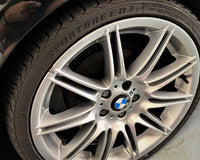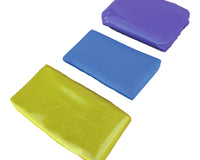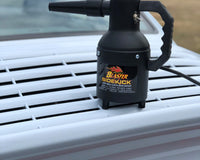When it comes to car detailing, one of the most satisfying sights for any car enthusiast is watching water bead up and roll off a freshly waxed or sealed surface. But have you ever wondered why this happens? The behaviour of water on your car’s surface isn’t just a visual treat—it’s a science. Understanding the principles of beading and sheeting can help you make informed decisions about how to protect and maintain your car’s paintwork.
In this blog post, we’ll dive deep into the science behind beading and sheeting, explore how they work, and discuss why they matter for your car’s longevity and appearance. Whether you’re a seasoned detailer or a car owner looking to up your maintenance game, this professional detailing guide will equip you with the knowledge you need.
What Are Beading and Sheeting?
Before we get into the science, let’s define the two key concepts:
Beading
Beading occurs when water forms small, round droplets on the surface of your car. These droplets sit on top of the paintwork and roll off easily when the car is in motion or tilted. Beading is often associated with a well-protected surface, such as one treated with wax, sealant, or ceramic coating.
Sheeting
Sheeting, on the other hand, happens when water spreads out into a thin, uniform layer across the surface of the car. Instead of forming droplets, the water flows off in sheets, often leaving the surface almost dry. This behaviour is typically seen on surfaces treated with certain types of coatings or hydrophobic products.
Both beading and sheeting are indicators of a protected surface, but they achieve this in different ways. Let’s explore the science behind these phenomena.
The Science Behind Beading and Sheeting
Surface Tension and Hydrophobicity
The behaviour of water on your car’s surface is largely determined by two factors: surface tension and hydrophobicity.
-
Surface Tension: Water molecules are naturally attracted to each other, creating a cohesive force that causes water to form droplets. This is why water beads up on surfaces.
-
Hydrophobicity: A hydrophobic surface repels water, causing it to bead up and roll off. This is achieved by creating a surface with low surface energy, which prevents water from spreading out.
When you apply a wax, sealant, or ceramic coating to your car, you’re essentially creating a hydrophobic layer. This layer reduces the surface energy, allowing water to bead up and roll off more easily.
Contact Angle: The Key to Beading
The contact angle is a critical concept in understanding beading. It refers to the angle at which a water droplet meets the surface of your car.
-
A high contact angle (greater than 90 degrees) indicates strong beading. The water droplets are more rounded and sit on top of the surface.
-
A low contact angle (less than 90 degrees) means the water spreads out, leading to sheeting.
Products like carnauba wax and ceramic coatings are designed to increase the contact angle, enhancing the beading effect.
Sheeting: The Role of Hydrophilic Coatings
While hydrophobic coatings promote beading, some products are designed to encourage sheeting. These coatings are often more hydrophilic, meaning they have a higher affinity for water.
When water comes into contact with a hydrophilic surface, it spreads out into a thin layer. This allows the water to flow off the surface more efficiently, often leaving fewer water spots behind.

Why Beading and Sheeting Matter for Your Car
Protection Against Contaminants
Beading and sheeting aren’t just about aesthetics—they play a crucial role in protecting your car’s paintwork.
-
Beading: When water beads up and rolls off, it takes dirt, dust, and other contaminants with it. This helps keep your car cleaner for longer and reduces the risk of scratches during washing.
-
Sheeting: Sheeting ensures that water doesn’t linger on the surface, minimising the risk of water spots caused by mineral deposits.
Enhanced Durability
A surface that promotes beading or sheeting is better equipped to withstand environmental challenges like UV rays, acid rain, and bird droppings. This can extend the life of your car’s paintwork and reduce the need for frequent detailing.
Easier Maintenance
Cars that exhibit strong beading or sheeting are easier to clean. Water and dirt slide off more easily, reducing the time and effort required for washing and drying.
How to Achieve Optimal Beading and Sheeting
Choose the Right Products
The key to achieving beading or sheeting lies in the products you use. Here’s a quick guide:
-
For Beading: Opt for carnauba wax, synthetic sealants, or ceramic coatings. These products create a hydrophobic surface that enhances beading.
-
For Sheeting: Look for coatings or sealants specifically designed to promote sheeting. These are often more hydrophilic and may contain polymers that encourage water to spread out.
Proper Application is Key
No matter which product you choose, proper application is essential. Follow these tips:
-
Clean the Surface: Ensure your car is thoroughly washed and decontaminated before applying any product.
-
Apply in Thin Layers: Use a microfiber applicator to apply the product in thin, even layers. This ensures maximum coverage and effectiveness.
-
Allow Time to Cure: Give the product enough time to bond with the surface. This can range from a few minutes for waxes to several hours for ceramic coatings.
Regular Maintenance
To maintain optimal beading and sheeting, reapply your chosen product regularly. Waxes and sealants typically last a few months, while ceramic coatings can last years with proper care.
Common Myths About Beading and Sheeting
Myth 1: More Beading Means Better Protection
While beading is a good indicator of a protected surface, it doesn’t necessarily mean the product is more durable. Some coatings that promote sheeting can offer equal or even better protection.
Myth 2: Sheeting is Always Better Than Beading
Sheeting is great for reducing water spots, but it may not provide the same level of dirt repellency as beading. The best choice depends on your specific needs and preferences.
Myth 3: Beading and Sheeting Last Forever
No product lasts forever. Over time, the hydrophobic or hydrophilic properties of your coating will diminish, requiring reapplication.
Conclusion: Mastering the Art of Water Behaviour
Understanding the science of beading and sheeting can transform the way you care for your car. By choosing the right products and applying them correctly, you can enhance your car’s appearance, protect its paintwork, and make maintenance a breeze.
Whether you prefer the mesmerising look of water beads or the practicality of sheeting, the key is to stay consistent with your detailing routine. After all, a well-protected car isn’t just a joy to drive—it’s a testament to your dedication as a car enthusiast.
So, the next time you see water gracefully rolling off your car, you’ll know it’s not just magic—it’s science!




